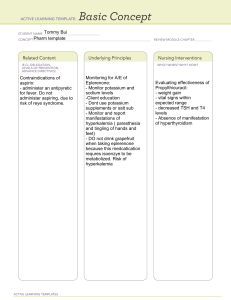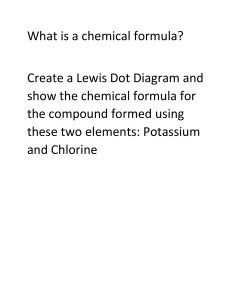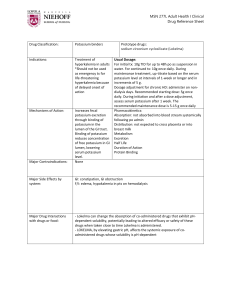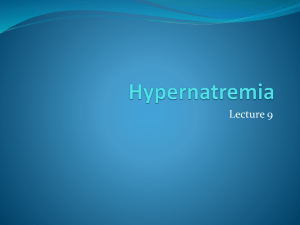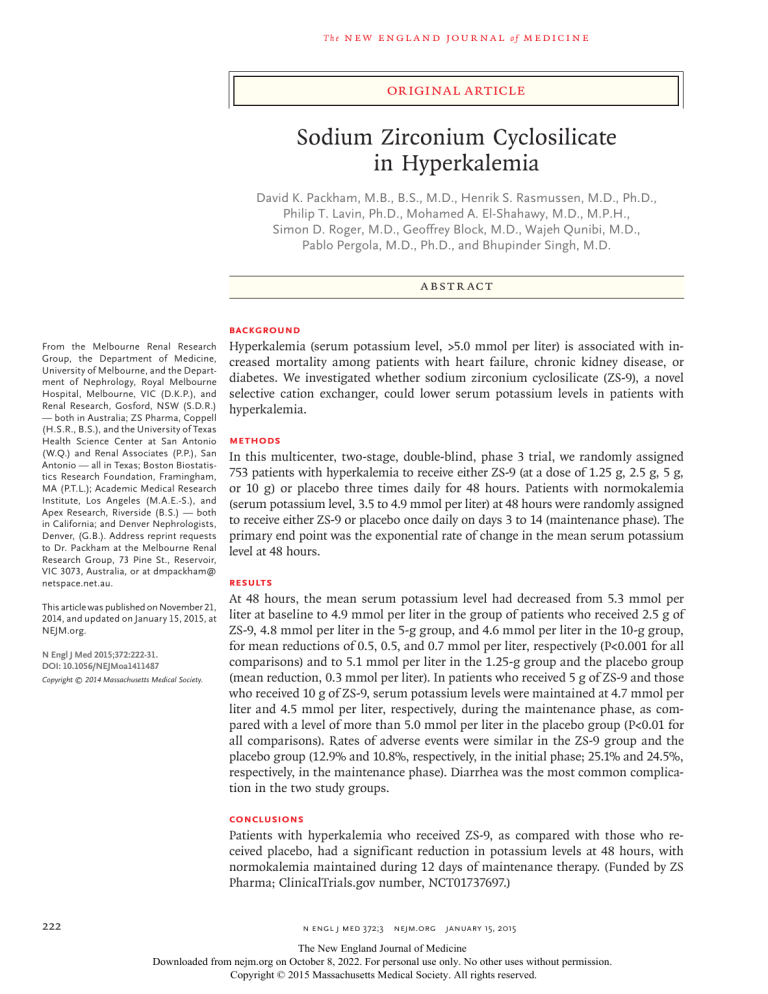
The n e w e ng l a n d j o u r na l of m e dic i n e original article Sodium Zirconium Cyclosilicate in Hyperkalemia David K. Packham, M.B., B.S., M.D., Henrik S. Rasmussen, M.D., Ph.D., Philip T. Lavin, Ph.D., Mohamed A. El-Shahawy, M.D., M.P.H., Simon D. Roger, M.D., Geoffrey Block, M.D., Wajeh Qunibi, M.D., Pablo Pergola, M.D., Ph.D., and Bhupinder Singh, M.D. A BS T R AC T Background From the Melbourne Renal Research Group, the Department of Medicine, University of Melbourne, and the Department of Nephrology, Royal Melbourne Hospital, Melbourne, VIC (D.K.P.), and Renal Research, Gosford, NSW (S.D.R.) — both in Australia; ZS Pharma, Coppell (H.S.R., B.S.), and the University of Texas Health Science Center at San Antonio (W.Q.) and Renal Associates (P.P.), San Antonio — all in Texas; Boston Biostatistics Research Foundation, Framingham, MA (P.T.L.); Academic Medical Research Institute, Los Angeles (M.A.E.-S.), and Apex Research, Riverside (B.S.) — both in California; and Denver Nephrologists, Denver, (G.B.). Address reprint requests to Dr. Packham at the Melbourne Renal Research Group, 73 Pine St., Reservoir, VIC 3073, Australia, or at dmpackham@ netspace.net.au. This article was published on November 21, 2014, and updated on January 15, 2015, at NEJM.org. N Engl J Med 2015;372:222-31. DOI: 10.1056/NEJMoa1411487 Copyright © 2014 Massachusetts Medical Society. Hyperkalemia (serum potassium level, >5.0 mmol per liter) is associated with increased mortality among patients with heart failure, chronic kidney disease, or diabetes. We investigated whether sodium zirconium cyclosilicate (ZS-9), a novel selective cation exchanger, could lower serum potassium levels in patients with hyperkalemia. Methods In this multicenter, two-stage, double-blind, phase 3 trial, we randomly assigned 753 patients with hyperkalemia to receive either ZS-9 (at a dose of 1.25 g, 2.5 g, 5 g, or 10 g) or placebo three times daily for 48 hours. Patients with normokalemia (serum potassium level, 3.5 to 4.9 mmol per liter) at 48 hours were randomly assigned to receive either ZS-9 or placebo once daily on days 3 to 14 (maintenance phase). The primary end point was the exponential rate of change in the mean serum potassium level at 48 hours. Results At 48 hours, the mean serum potassium level had decreased from 5.3 mmol per liter at baseline to 4.9 mmol per liter in the group of patients who received 2.5 g of ZS-9, 4.8 mmol per liter in the 5-g group, and 4.6 mmol per liter in the 10-g group, for mean reductions of 0.5, 0.5, and 0.7 mmol per liter, respectively (P<0.001 for all comparisons) and to 5.1 mmol per liter in the 1.25-g group and the placebo group (mean reduction, 0.3 mmol per liter). In patients who received 5 g of ZS-9 and those who received 10 g of ZS-9, serum potassium levels were maintained at 4.7 mmol per liter and 4.5 mmol per liter, respectively, during the maintenance phase, as compared with a level of more than 5.0 mmol per liter in the placebo group (P<0.01 for all comparisons). Rates of adverse events were similar in the ZS-9 group and the placebo group (12.9% and 10.8%, respectively, in the initial phase; 25.1% and 24.5%, respectively, in the maintenance phase). Diarrhea was the most common complication in the two study groups. Conclusions Patients with hyperkalemia who received ZS-9, as compared with those who received placebo, had a significant reduction in potassium levels at 48 hours, with normokalemia maintained during 12 days of maintenance therapy. (Funded by ZS Pharma; ClinicalTrials.gov number, NCT01737697.) 222 n engl j med 372;3 nejm.org january 15, 2015 The New England Journal of Medicine Downloaded from nejm.org on October 8, 2022. For personal use only. No other uses without permission. Copyright © 2015 Massachusetts Medical Society. All rights reserved. Sodium Zirconium Cyclosilicate in Hyperk alemia H yperkalemia (serum potassium level, >5.0 mmol per liter) is a common electrolyte disorder that is associated with serious cardiac dysrhythmias and increased mortality.1-3 Patients with renal dysfunction and those with diabetes are at increased risk for hyperkalemia.3 Therapies that inhibit the renin–angiotensin–aldosterone system (RAAS) are associated with hyperkalemia in patients with kidney disease or heart failure,4,5 despite strong evidence that such therapy is beneficial in proteinuric chronic kidney disease,6-9 diabetic nephropathy,10-12 and systolic heart failure.12-15 The use of existing polymer resins (e.g., sodium polystyrene sulfonate) has a poor side-effect profile and uncertain efficacy. Thus, there is a need for additional agents that can safely treat hyperkalemia in both patients with acute disease and those with chronic disease. Sodium zirconium cyclosilicate (ZS-9) is a highly selective cation exchanger that entraps potassium in the intestinal tract in exchange for sodium and hydrogen (Fig. S1 in the Supplementary Appendix, available with the full text of this article at NEJM.org).16 In a phase 2 study, ZS-9, as compared with placebo, was associated with significant reductions in serum potassium levels within the first 48 hours of treatment in patients with stage 3 chronic kidney disease (estimated glomerular filtration rate [eGFR], 30 to 60 ml per minute per 1.73 m2 of body-surface area) and serum potassium levels of 5 to 6 mmol per liter.17 Here, we report the results of a phase 3, two-stage, double-blind, randomized, placebocontrolled, dose-ranging trial of ZS-9 for the treatment of hyperkalemia. Me thods Patients From November 2012 through November 2013, we recruited patients at 65 sites in the United States, Australia, and South Africa (mean number of patients per site, 12). Eligible patients were at least 18 years of age, had a serum potassium level of 5.0 to 6.5 mmol per liter, and were able to undergo repeated blood draws. Patients were excluded if they were receiving dialysis, had diabetic ketoacidosis, had a potassium level of more than 6.5 mmol per liter, had cardiac arrhythmia that required immediate treatment, or had received organic polymer resins or phosphate bind- n engl j med 372;3 ers within 1 week before enrollment. There were no specific requirements for the eGFR, nor were patients excluded on the basis of the date of initiation of a RAAS inhibitor. Full inclusion and exclusion criteria are provided in the complete study protocol, available at NEJM.org. All patients provided written informed consent. Study Design, Randomization, and Treatment The study was conducted in two randomized phases: an initial phase and a maintenance phase. At the time of screening (day 0), we used a point-of-care device (i-STAT, Abbott Laboratories) to measure potassium levels in whole blood obtained from patients who had been instructed to fast for 12 hours, with samples obtained at baseline, at 30 minutes, and at 60 minutes (Fig. 1). All samples were centrifuged on site, and serum samples were sent to a central laboratory for analysis and verification. We established randomization assignments for the two phases of the study at baseline. Patients with a potassium level of 5.0 to 6.5 mmol per liter (the mean of three measurements) were randomly assigned to receive 1.25 g, 2.5 g, 5 g, or 10 g of ZS-9 or placebo, administered three times daily with meals for the initial 48 hours (initial phase); the first two doses were administered at the study site and the third dose at home. Patients in the ZS-9 group in whom a serum potassium level of 3.5 to 4.9 mmol per liter was reached at 48 hours were randomly assigned in a 1:1 ratio, with blinding preserved, to receive either their original ZS-9 dose or placebo once daily before breakfast on days 3 to 14 (maintenance phase). Patients assigned to the placebo group in the initial phase were randomly assigned to receive either 1.25 g or 2.5 g of ZS-9 in the maintenance phase (Fig. 1). Study drug dose adjustment during the study was not allowed. All concomitant medications were kept constant throughout the study, including diuretic agents, RAAS inhibitors, and antidiabetic therapies. No dietary restrictions were imposed; patients were instructed to continue their usual diet without any specified alterations. Study stopping rules are included in the protocol. An institutional review board or independent ethics committee at each participating institution approved the study, which was conducted in accordance with the Good Clinical Practice guidelines and the provisions of the Declaration nejm.org january 15, 2015 The New England Journal of Medicine Downloaded from nejm.org on October 8, 2022. For personal use only. No other uses without permission. Copyright © 2015 Massachusetts Medical Society. All rights reserved. 223 The n e w e ng l a n d j o u r na l of m e dic i n e Primary End Point (initial phase) Secondary End Point (maintenance phase) Exponential rate of change in serum potassium over 48 hr Exponential rate of change in serum potassium over 12-day treatment interval Patients with normokalemia on morning of day 3 may proceed to maintenance phase 2 Days 12 Days 7 Days Initial phase Maintenance phase Follow-up Dose Dose (once daily) (3× daily) ZS-9, 1.25 g Placebo ZS-9, 2.5 g Placebo ZS-9, 1.25 g ZS-9, 1.25 g Placebo ZS-9, 2.5 g ZS-9, 2.5 g Placebo ZS-9, 5 g ZS-9, 5 g Placebo ZS-9, 10 g 1 2 ZS-9, 10 g 3 4 5 6 7 8 9 10 11 12 13 14 15 21 Study Day ZS-9 Dose Potassium Measurement Figure 1. Study Design. Patients in any of the ZS-9 groups whose serum potassium level decreased to 3.5 to 4.9 mmol per liter at 48 hours during the initial phase of the study were randomly assigned to receive either their original ZS-9 dose or placebo once daily before breakfast on days 3 to 14 during the maintenance phase. Patients assigned to the placebo group in the initial phase were randomly assigned to receive either 1.25 g or 2.5 g of ZS-9 in the maintenance phase. 224 of Helsinki. An independent data and safety monitoring committee reviewed safety data at prespecified intervals and administered specified safety stopping rules. rately for each of the four dose groups in the initial phase, as compared with the corresponding placebo group. Other end points are described in the study protocol. Primary End Points Study Oversight The primary efficacy end point for the initial phase was the between-group difference in the exponential rate of change in the mean serum potassium level during the first 48 hours of treatment. We chose the exponential rate of change as a more clinically relevant end point than the absolute change from baseline, since it includes the time to onset and incorporates all potassium measurements throughout the initial 48 hours. The efficacy end point for the maintenance phase was the between-group difference in the mean serum potassium level during the 12-day treatment interval, which was analyzed sepa- All the authors had access to the complete study data, which were held by the sponsor, ZS Pharma. The first draft of the article was written by the first author and the last two authors, with editorial assistance paid for by ZS Pharma. The manuscript was reviewed and approved by all coauthors. All the authors vouch for the accuracy and completeness of the data and the analyses. n engl j med 372;3 Statistical Analysis All statistical analyses were performed on serum measurements from the central laboratory. We conducted 15 prespecified analyses on the basis nejm.org january 15, 2015 The New England Journal of Medicine Downloaded from nejm.org on October 8, 2022. For personal use only. No other uses without permission. Copyright © 2015 Massachusetts Medical Society. All rights reserved. Sodium Zirconium Cyclosilicate in Hyperk alemia of the baseline serum potassium level, eGFR, RAAS-inhibitor use (yes vs. no), and status with respect to a history of diabetes, heart failure, or chronic kidney disease (regardless of the eGFR). We also conducted subgroup analyses for patients with a combination of heart failure, diabetes mellitus, and reduced renal function (eGFR, <60 ml per minute per 1.73 m2) (Table S2 and Fig. S2 in the Supplementary Appendix). The study was not powered to reach conclusions in subgroup analyses, so the results of these analyses should be regarded only as descriptive findings. Safety end points included adverse events, vital signs, and findings on electrocardiography, hematologic analyses, and other relevant laboratory analyses, including the incidence of hypokalemia (serum potassium level, <3.5 mmol per liter) and hypomagnesemia (serum magnesium level, <0.6 mmol per liter). The results of the safety analyses are descriptive only, since the study was not powered to detect these adverse events. The primary efficacy analyses were performed in the intention-to-treat populations, including patients who received at least one dose of the assigned study drug and in whom serum potassium was measured after baseline, separately for the initial and maintenance phases. Separate efficacy and safety analyses were performed for the two study phases. For tests of the primary efficacy end point during the two phases, the study had a power of 90% with a two-tailed type I error rate of 0.05. We used a predefined closed testing procedure, in which we first tested the highest dose in the initial phase, then the corresponding highest dose in the maintenance phase, then the next highest dose in the initial phase and then in the maintenance phase, until the lowest dose was reached. The type I error for multiple testing of doses and end points was prospectively defined.18 We compared the between-group difference in efficacy using a generalized estimating equation model for continuous end points and a two-sided Fisher’s exact test for binary outcomes. initial phase of the study (Fig. 2). Of 753 patients who could be evaluated, 543 (72.1%) continued into the maintenance phase, which was completed by more than 90% of patients in each study group. Baseline characteristics before the initial phase did not differ significantly between the two study groups, except for the serum potassium level (Table 1, and Table S1 in the Supplementary Appendix). The mean age was 65 years (range, 22 to 93); 60% of the patients were men, and 86% were white. A total of 561 patients (74.5%) had an eGFR of less than 60 ml per minute per 1.73 m2 (as calculated with the use of the Modification of Diet in Renal Disease equation), 502 patients (66.7%) were receiving RAAS inhibitors, 451 (59.9%) had diabetes, and 300 (39.8%) had a history of heart failure. There were no significant between-group differences with respect to changes in concomitant therapies, including RAAS inhibitors, diuretics, and antidiabetic drugs. Efficacy Initial Phase ZS-9 was associated with a significant decrease in the serum potassium level from baseline to 48 hours among patients receiving 2.5 g, those receiving 5 g, and those receiving 10 g of the drug (Fig. 3A, and Fig. S3A in the Supplementary Appendix). At 48 hours, the mean exponential rates of change from baseline per hour were reductions of 0.11% in the group receiving 1.25 g of ZS-9, 0.16% in the group receiving 2.5 g, 0.21% in the group receiving 5 g, and 0.30% in the group receiving 10 g, as compared with a reduction of 0.09% per hour in the placebo group (P<0.001 for the comparison with the three highest-dose groups; P>0.05 for the comparison with the 1.25-g group). At 48 hours, there were absolute mean reductions of 0.46 mmol per liter (95% confidence interval [CI], −0.53 to −0.39) in the 2.5-g group, 0.54 mmol per liter (95% CI, −0.62 to −0.47) in the 5-g group, and 0.73 mmol per liter (95% CI, −0.82 to −0.65) in the 10-g group, as compared with a mean reduction of 0.25 mmol per liter (95% CI, −0.32 to −0.19) in the placebo group (P<0.001 for all comparisons). The mean reducR e sult s tion from baseline at 1 hour after the first 10-g Patients dose of ZS-9 was 0.11 mmol per liter (95% CI, Of the 1433 patients who were screened, 754 −0.17 to −0.05), as compared with an increase of were randomly assigned to one of the four ZS-9 0.01 mmol per liter (95% CI, −0.05 to 0.07) in dose groups or to the placebo group during the the placebo group (P = 0.009) (Fig. 3A). During n engl j med 372;3 nejm.org january 15, 2015 The New England Journal of Medicine Downloaded from nejm.org on October 8, 2022. For personal use only. No other uses without permission. Copyright © 2015 Massachusetts Medical Society. All rights reserved. 225 226 n engl j med 372;3 nejm.org 2 Discontinued study 1 Had adverse event 1 Withdrew consent 41 Were assigned to receive placebo 49 Were assigned to receive ZS-9, 1.25 g 2 Discontinued study owing to withdrawal of consent 46 Were assigned to receive placebo 1 Discontinued study owing to investigator’s decision 54 Were assigned to receive ZS-9, 2.5 g 65 Were assigned to receive ZS-9, 5 g 1 Discontinued 2 Discontinued study study owing to 1 Had withdrawal adverse of consent event 1 Died 68 Were assigned to receive placebo 2 Discontinued study 1 Withdrew consent 1 Had hyperkalemia 61 Were assigned to receive placebo 63 Were assigned to receive ZS-9, 10 g of january 15, 2015 The New England Journal of Medicine Downloaded from nejm.org on October 8, 2022. For personal use only. No other uses without permission. Copyright © 2015 Massachusetts Medical Society. All rights reserved. Figure 2. Enrollment and Outcomes. 50 Were assigned to receive ZS-9, 2.5 g Maintenance Phase (days 3–14) n e w e ng l a n d j o u r na l 1 Discontinued study owing to hyperkalemia 45 Were assigned to receive ZS-9, 1.25 g Initial Phase (0–48 hr) 3 Discontinued study 1 Had adverse event 1 Was nonadherent 1 Was lost to follow-up 16 Did not enter maintenance phase 13 Had hyperkalemia 2 Had hypokalemia 1 Withdrew consent 143 Were assigned to receive ZS-9, 10 g 6 Discontinued study (including 1 who did not receive study drug) 4 Withdrew consent 1 Had adverse event 1 Had other reasons 19 Did not enter maintenance phase 18 Had hyperkalemia 1 Withdrew consent 158 Were assigned to receive ZS-9, 5 g 4 Discontinued study 1 Withdrew consent 3 Had hyperkalemia 37 Did not enter maintenance phase 36 Had hyperkalemia 1 Was withdrawn by sponsor 141 Were assigned to receive ZS-9, 2.5 g 4 Discontinued study 1 Had adverse event 1 Withdrew consent 1 Was withdrawn by sponsor 1 Had hyperkalemia 60 Did not enter maintenance phase owing to hyperkalemia 154 Were assigned to receive ZS-9, 1.25 g 1 Discontinued study owing to hyperkalemia 61 Did not enter maintenance phase owing to hyperkalemia 158 Were assigned to receive placebo 754 Underwent randomization 679 Were excluded 625 Had potassium <5.0 mmol/liter 3 Had potassium >6.5 mmol/liter 14 Withdrew consent 9 Were withdrawn by investigator 1 Was nonadherent 1 Had hypokalemia 26 Had other reasons 1433 Patients were assessed for eligibility The m e dic i n e Sodium Zirconium Cyclosilicate in Hyperk alemia Table 1. Characteristics of the Patients at Baseline.* Placebo (N = 158) Characteristic ZS-9 1.25 g (N = 154) 2.5 g (N = 141) 5g (N = 157) 10 g (N = 143) Age — yr 65.6±12.2 65.4±13.1 65.9±11.7 65.2±11.9 66.2±12.2 Male sex — no. (%) 98 (62.0) 83 (53.9) 91 (64.5) 96 (61.1) 80 (55.9) White 136 (86.1) 131 (85.1) 125 (88.7) 132 (84.1) 120 (83.9) Black 17 (10.8) 20 (13.0) 11 (7.8) 20 (12.7) 19 (13.3) 5.0–5.3 mmol/liter 95 (60.1) 76 (49.4) 72 (51.1) 90 (57.3) 94 (65.7) 5.4–5.5 mmol/liter 22 (13.9) 38 (24.7) 29 (20.6) 36 (22.9) 27 (18.9) 5.6–6.5 mmol/liter 41 (25.9) 40 (26.0) 40 (28.4) 31 (19.7) 22 (15.4) Chronic kidney disease 96 (60.8) 102 (66.2) 89 (63.1) 93 (59.2) 83 (58.0) Heart failure 66 (41.8) 57 (37.0) 54 (38.3) 64 (40.8) 59 (41.3) Race — no. (%)† Baseline serum potassium — no. (%) Medical history — no. (%) Diabetes mellitus Use of RAAS inhibitor — no. (%) 96 (60.8) 94 (61.0) 84 (59.6) 96 (61.1) 81 (56.6) 101 (63.9) 109 (70.8) 97 (68.8) 99 (63.1) 96 (67.1) * Plus–minus values are means ±SD. There were no significant differences among the groups at baseline, except for the serum potassium level (P = 0.03 for the overall comparison among the five study groups). RAAS denotes renin–angiotensin–aldosterone system. † Race was self-reported. study day 2 (24 to 48 hours), significantly greater mean reductions in serum potassium levels were observed at all time points among patients receiving ZS-9 than among those receiving placebo in the 2.5-g group (P<0.05 for all comparisons), the 5-g group (P<0.001), and the 10-g group (P<0.001) (Fig. 3A). At the 5-g and 10-g doses, the normalization of serum potassium (to levels of 3.5 to 4.9 mmol per liter) was observed, regardless of the baseline potassium level, eGFR, and status with respect to RAAS-inhibitor use and history of heart failure, chronic kidney disease, or diabetes. At the 10-g dose, the mean reduction in the serum potassium level was 1.1 mmol per liter in patients with a baseline potassium level of more than 5.5 mmol, 1.0 mmol per liter in patients with a baseline potassium level of 5.4 to 5.5 mmol per liter, and 0.6 mmol per liter in patients with a baseline potassium level of 5.3 mmol per liter or less. Normokalemia was reached on average in all three dose groups within 48 hours (P<0.001 for all comparisons with placebo). n engl j med 372;3 Maintenance Phase During the maintenance phase, both the 5-g and 10-g daily doses of ZS-9 were significantly superior to placebo in maintaining normokalemia (P = 0.008 and P<0.001, respectively), with hyperkalemia recurring in patients assigned to placebo who had received 5 g or 10 g of ZS-9 during the initial phase (Fig. 3B and 3C). The mean exponential rate of change was an increase of 0.14% per hour in the group receiving 10 g of ZS-9 versus 1.04% per hour in the respective placebo group (P<0.001), and an increase of 0.09% per hour with 5 g of ZS-9 versus 0.47% per hour with placebo (P = 0.008) (Fig. S3 in the Supplementary Appendix); the mean exponential rate of change with the two lowest doses of ZS-9 did not differ significantly from the rates with placebo. When the 10-g dose was discontinued after day 15, hyperkalemia redeveloped in patients within 1 week. Adverse Events Adverse events were reported in 12.9% of patients in the ZS-9 group and 10.8% of those in the placebo group during the initial phase (Table 2, and nejm.org january 15, 2015 The New England Journal of Medicine Downloaded from nejm.org on October 8, 2022. For personal use only. No other uses without permission. Copyright © 2015 Massachusetts Medical Society. All rights reserved. 227 The n e w e ng l a n d j o u r na l A Placebo (N=158) ZS-9, 5 g (N=157) ZS-9, 10 g (N=143) Dose *P<0.05 Serum Potassium (mmol/liter) 5.4 5.2 * * 5.0 * * * 4.8 * * * 4.6 * * * 4.4 0.0 B Placebo (N=68) On Drug Serum Potassium (mmol/liter) 5.4 ZS-9, 5 g (N=64) *P<0.05 On Drug vs. Placebo Off Drug 5.2 5.0 * ** 4.8 * * * * 4.6 4.4 1 2 3 4 5 6 7 8 9 10 11 12 13 14 15 16 17 18 19 20 21 Initial Day C Placebo (N=61) On Drug Serum Potassium (mmol/liter) 5.4 5.2 On Drug vs. Placebo *P<0.05 Off Drug * * * 4.8 * * * 4.6 * * 1 2 3 4 5 * * 4.4 Initial 228 ZS-9, 10 g (N=63) 5.0 0.0 m e dic i n e Figure 3. Potassium Levels during the Study. During the initial phase of the study (Panel A), mean potassium levels in patients who received either 5 g or 10 g of ZS-9 three times daily, as compared with placebo, were significantly reduced at most time points (as indicated by asterisks). The reduction in serum potassium levels was significant as early as 1 hour after the administration of the initial 10-g dose. During the maintenance phase of the study, normokalemia was maintained in patients who received 5 g of ZS-9 (Panel B) or 10 g of ZS-9 (Panel C) once daily, whereas potassium levels increased to the level of hyperkalemia in those who received placebo. Similarly, after each dose of ZS-9 was discontinued at day 15, hyperkalemia redeveloped within 1 week after treatment discontinuation. 0 2 4 6 8 10 12 14 16 18 20 22 24 26 28 30 32 34 36 38 40 42 44 46 48 Hour 0.0 of 6 7 8 9 10 11 12 13 14 15 16 17 18 19 20 21 Day n engl j med 372;3 Table S3 in the Supplementary Appendix). During the maintenance phase, adverse events were reported in 25.1% of patients receiving ZS-9 and in 24.5% of those receiving placebo. The most common adverse event at all dose levels and during both study phases was diarrhea (frequency in the initial phase, 1.8% in the ZS-9 group and 2.5% in the placebo group; frequency in the maintenance phase, 1.7% and 2.2%, respectively). A single event of gastroenteritis in the placebo group was the only serious adverse event that was deemed to be possibly drug-related by the investigator (Table S4 in the Supplementary Appendix). The single death, which was reportedly due to underlying chronic obstructive pulmonary disease and coronary artery disease in a patient in the ZS-9 group, was deemed by the investigator to be unrelated to the study drug. In the ZS-9 group, two cases of hypokalemia (serum potassium level, 3.1 mmol per liter in a patient receiving the 2.5-g dose in the maintenance phase and 3.4 mmol per liter in a patient receiving the 10-g dose in the initial phase) were reported. Both cases were transient and resolved without potassium repletion. A dose-dependent increase in serum bicarbonate was observed, which was consistent with the effect of a decrease in serum potassium. No other clinically significant changes in vital signs or in levels of blood glucose or electrolytes other than potassium were observed throughout the study, nor was there evidence of increased blood pressure, body weight, or edema (Table S5 in the Supplementary Appendix). Rates of clinically significant arrhythmia did nejm.org january 15, 2015 The New England Journal of Medicine Downloaded from nejm.org on October 8, 2022. For personal use only. No other uses without permission. Copyright © 2015 Massachusetts Medical Society. All rights reserved. 0 Urinary tract infection n engl j med 372;3 No. of patients nejm.org 0 2 (4.3) Cardiac disorder‡ Urinary tract infection 1 (2.0) 0 2 (4.0) 12 (24.0) 50 2 (4.9) 0 1 (2.4) 13 (31.7) 41 Placebo 1 (2.0) 0 0 14 (28.6) 49 ZS-9, 1.25 g 3 (1.9) 1 (0.6) 7 (4.5) 25 (16.2) 0 0 2 (4.3) 9 (19.6) 46 Placebo 0 0 1 (1.9) 1 (1.9) 4 (7.4) 11 (20.4) 54 ZS-9, 2.5 g 3 (2.1) 13 (9.2) 141 ZS-9, 2.5 g 1 (1.5) 1 (1.5) 5 (7.4) 16 (23.5) 68 Placebo 3 (4.6) 2 (3.1) 5 (7.7) 14 (21.5) 65 ZS-9, 5 g 1 (0.6) 3 (1.9) 6 (3.8) 22 (14.0) 157 ZS-9, 5 g 0 1 (1.6) 0 15 (24.6) 61 Placebo 0 1 (1.6) 2 (3.2) 3 (4.8) 21 (33.3) 63 ZS-9, 10 g 2 (1.4) 5 (3.5) 17 (11.9) 143 ZS-9, 10 g * Patients in the ZS-9 group who had a serum potassium level of 3.5 to 4.9 mmol per liter at 48 hours during the initial phase of the study were randomly assigned to receive either their original ZS-9 dose or placebo once daily before breakfast on days 3 to 14 during the maintenance phase. Patients in the placebo group in the initial phase were randomly assigned to receive either 1.25 g or 2.5 g of ZS-9 in the maintenance phase. † Gastrointestinal disorders included diarrhea, constipation, nausea, vomiting, abdominal pain, abdominal distention, dyspepsia, flatulence, gastric ulcers, gastritis, and frequent bowel movements. ‡ Cardiac disorders included atrial fibrillation, atrial flutter, bradycardia, palpitations, sinus tachycardia, ventricular extrasystole, left-sided bundle-branch block, congestive cardiac failure, cardiovascular disorder, diastolic dysfunction, and the long-QT syndrome. 4 (8.7) 10 (21.7) 46 Gastrointestinal disorder† Any Adverse event — no. (%) ZS-9, 2.5 g 0 Cardiac disorder‡ ZS-9, 1.25 g 8 (5.1) Adverse Events in Maintenance Phase 17 (10.8) 154 158 Gastrointestinal disorder† ZS-9, 1.25 g Placebo Any Adverse event — no. (%) No. of patients Adverse Events in Initial Phase Table 2. Adverse Events during Initial Phase and Maintenance Phase.* Sodium Zirconium Cyclosilicate in Hyperk alemia january 15, 2015 The New England Journal of Medicine Downloaded from nejm.org on October 8, 2022. For personal use only. No other uses without permission. Copyright © 2015 Massachusetts Medical Society. All rights reserved. 229 The n e w e ng l a n d j o u r na l not differ between any ZS-9 dose group and the placebo group, nor were there significant differences in the PR interval or QRS complex. An increase in the corrected QT (QTc) interval was observed among patients in the ZS-9 group during the initial phase, which was consistent with the decrease in serum potassium levels and was dose-related. Mean increases in the QTc interval ranged from 0.03 msec at the lowest ZS-9 dose (1.25 g) to 7.61 msec at the highest ZS-9 dose (10 g) on study day 2, and from 0.38 msec at the lowest ZS-9 dose to 10.3 msec at the highest ZS-9 dose on study day 3. Small, clinically nonsignificant decreases in the mean QTc interval were noted in each ZS-9 dose group on day 15. During the initial phase, one patient receiving 10 g of ZS-9 had an increase of 71 msec in the QTc interval, which resulted in a QTc interval of 516 msec on day 3 while the patient was receiving concomitant treatment with ciprofloxacin (a drug that has been associated with prolongation of the QTc interval). However, the QTc interval in this patient returned to the baseline level during the maintenance phase after ciprofloxacin was discontinued. Discussion Our results indicate that ZS-9 is a potent, selective potassium trap that corrects hyperkalemia within 48 hours. A clinically significant treatment effect was observed within 1 hour after administration. The decline in the potassium level was rapid and dose-dependent, starting at a dose of 2.5 g three times daily. The reduction in serum potassium levels with ZS-9 was most pronounced in patients with the highest potassium levels at baseline. ZS-9 effectively normalized potassium levels in patients who were receiving RAAS inhibitors for the treatment of cardiovascular or renal disease, a group in which a dose reduction or discontinuation of these drugs is often needed. Normal serum potassium levels were maintained with once-daily doses of 5 g or 10 g of ZS-9. The drug was equally effective across various subgroups, including patients with a combination of heart failure, chronic kidney disease, and diabetes. Hyperkalemia is common, particularly in patients with chronic kidney disease, diabetes, or heart failure and in those receiving RAAS inhibitors.3-5 Available therapies for initial treatment (insulin, beta-2 stimulants, and sodium 230 n engl j med 372;3 of m e dic i n e bicarbonate) simply promote translocation of potassium from the extracellular space to the intracellular space, providing temporary benefit, for approximately 1 to 4 hours. Removal of potassium from the body entails the use of exchange resins, diuretics, or dialysis. The current mainstay for the acute removal of potassium is the use of nonspecific polymeric exchange resins (sodium or calcium polystyrene sulfonate). These agents have uncertain efficacy and generally poor side-effect profiles and have been associated with serious gastrointestinal adverse events,19,20 particularly when administered with sorbitol.21-24 In patients with less severe, chronic hyperkalemia, a common early intervention is to limit potassium intake. However, a low-potassium diet is restrictive and deprives patients of many food choices that are otherwise associated with improved renal outcomes.25-30 Among patients who are receiving RAAS inhibitors or who would benefit from the protective effects of these drugs, hyperkalemia prevents the most effective therapy at the full target dose. Thus, there is a need for new treatment options that can be used in patients with acute or chronic disease, have an acceptable safety profile, and cause a rapid and sustained reduction of potassium levels. The potassium-lowering action of ZS-9 is based on size-selective micropores in the zirconium silicate crystal structure, which traps potassium in the intestinal tract in exchange for protons and sodium. The potassium-binding capacity of ZS-9 is 9 times that of organic polymer resins (e.g., sodium polystyrene sulfonate) and is more selective by a factor of more than 125 for potassium over calcium.16 ZS-9 is insoluble, does not swell on contact with water, and is not systemically absorbed, according to mass balance studies in animal models showing fecal excretion of zirconium of more than 99% after ingestion.17 The stable crystal structure of ZS-9 enables binding of potassium throughout the gastrointestinal tract, which probably explains the significant fall in serum potassium levels within 1 hour after the first 10-g dose. These features may also contribute to the low incidence of gastrointestinal and systemic adverse events. The overall safety profile of ZS-9 in our study was similar to that of placebo. There were no cases of a decrease in potassium levels of more than 3.0 mmol per liter. Transient hypokalemia developed in two patients (with potassium levels of 3.1 and 3.4 mmol per liter). nejm.org january 15, 2015 The New England Journal of Medicine Downloaded from nejm.org on October 8, 2022. For personal use only. No other uses without permission. Copyright © 2015 Massachusetts Medical Society. All rights reserved. Sodium Zirconium Cyclosilicate in Hyperk alemia A major limitation of this study was that patients who had a serum potassium level of more than 6.5 mmol per liter or electrocardiographic changes associated with hyperkalemia were excluded. Another limitation was the short-term nature of the study, since patients in the study population might have required more than 14 days of treatment. Finally, since the study was conducted among ambulatory outpatients, it excluded hospitalized patients and those receiving dialysis. In conclusion, ZS-9, as compared with placebo, was associated with a decrease in serum potassium levels within 48 hours after administration in a cohort of ambulatory patients with baseline potassium levels of 5.0 to 6.5 mmol per liter. In patients who continued to receive ZS-9, normokalemia was maintained for 14 days. Supported by ZS Pharma. Disclosure forms provided by the authors are available with the full text of this article at NEJM.org. We thank the patients who participated in this study; Dr. Alex Yang for data analysis and critical review of the manuscript; Alan Chang for assistance in the preparation of the manuscript; staff members at Boston Biostatistics Research Foundation for providing analysis support; and Drs. Mark Rocco, Regina Burris, and Ingrid Koo of Xelay Acumen for their editorial assistance. References 1. Khanagavi J, Gupta T, Aronow WS, et al. Hyperkalemia among hospitalized patients and association between duration of hyperkalemia and outcomes. Arch Med Sci 2014;10:251-7. 2. An JN, Lee JP, Jeon HJ, et al. Severe hyperkalemia requiring hospitalization: predictors of mortality. Crit Care 2012;16: R225. 3. Jain N, Kotla S, Little BB, et al. Predictors of hyperkalemia and death in patients with cardiac and renal disease. Am J Cardiol 2012;109:1510-3. 4. Navaneethan SD, Nigwekar SU, Sehgal AR, Strippoli GF. Aldosterone antagonists for preventing the progression of chronic kidney disease. Cochrane Database Syst Rev 2009;3:CD007004. 5. Svensson M, Gustafsson F, Galatius S, Hildebrandt PR, Atar D. How prevalent is hyperkalemia and renal dysfunction during treatment with spironolactone in patients with congestive heart failure? J Card Fail 2004;10:297-303. 6. Ahn SY, Ryu J, Baek SH, et al. Incident chronic kidney disease and newly developed complications related to renal dysfunction in an elderly population during 5 years: a community-based elderly population cohort study. PLoS One 2013;8(12):e84467. 7. Tylicki L, Lizakowski S, Rutkowski B. Renin-angiotensin-aldosterone system blockade for nephroprotection: current evidence and future directions. J Nephrol 2012;25:900-10. 8. Palmer BF, Fenves AZ. Optimizing blood pressure control in patients with chronic kidney disease. Proc (Bayl Univ Med Cent) 2010;23:239-45. 9. Berl T. Review: renal protection by inhibition of the renin-angiotensin-aldosterone system. J Renin Angiotensin Aldosterone Syst 2009;10:1-8. 10. St Peter WL, Odum LE, Whaley-Connell AT. To RAS or not to RAS? The evidence for and cautions with renin-angiotensin system inhibition in patients with diabetic kidney disease. Pharmacotherapy 2013;33:496-514. 11. Estacio RO. Renin-angiotensin-aldo- sterone system blockade in diabetes: role of direct renin inhibitors. Postgrad Med 2009;121:33-44. 12. Stojiljkovic L, Behnia R. Role of renin angiotensin system inhibitors in cardiovascular and renal protection: a lesson from clinical trials. Curr Pharm Des 2007; 13:1335-45. 13. McCullough PA, Beaver TM, BennettGuerrero E, et al. Acute and chronic cardiovascular effects of hyperkalemia: new insights into prevention and clinical management. Rev Cardiovasc Med 2014;15:1123. 14. Vardeny O, Claggett B, Anand I, et al. Incidence, predictors and outcomes related to hypo- and hyperkalemia in patients with severe heart failure treated with a mineralocorticoid receptor antagonist. Circ Heart Fail 2014;7:573-9. 15. Pitt B, Zannad F, Remme WJ, et al. The effect of spironolactone on morbidity and mortality in patients with severe heart failure. N Engl J Med 1999;341:709-17. 16. Yang A, Leon A, Nuttall M, Low J, Rasmussen H. In vitro ion exchange capacity and selectivity of ZS-9, a novel, selective cation trap for the treatment of hyperkalemia. Adv Chronic Kidney Dis 2014;21:247. 17. Ash SR, Singh B, Lavin PT, Stavros F, Rasmussen HS. Safety and efficacy of ZS 9, a novel selective cation trap, for treatment of hyperkalemia in patients with chronic kidney disease. Kidney Int (in press). 18. Dmitrienko A, Tamhane AC, Wang X, Chen X. Stepwise gatekeeping procedures in clinical trial applications. Biom J 2006; 48:984-9 [Erratum, Biom J 2006;48:1041.] 19. Sterns RH, Rojas M, Bernstein P, Chennupati S. Ion-exchange resins for the treatment of hyperkalemia: are they safe and effective? J Am Soc Nephrol 2010; 21:733-5. 20. Castillo-Cejas MD, De-Torres-Ramírez I, Alonso-Cotoner C. Colonic necrosis due to calcium polystyrene sulfonate (Kalimate) not suspended in sorbitol. Rev Esp Enferm Dig 2013;105:232-4. 21. Harel Z, Harel S, Shah PS, Wald R, n engl j med 372;3 nejm.org Perl J, Bell CM. Gastrointestinal adverse events with sodium polystyrene sulfonate (Kayexalate) use: a systematic review. Am J Med 2013;126(3):264.e9–264.e24. 22. Tongyoo A, Sriussadaporn E, Limpavitayaporn P, Mingmalairak C. Acute intestinal obstruction due to Kalimate, a potassium-lowering agent: a case report and literature review. J Med Assoc Thai 2013;96:1617-20. 23. Yuan CM, Nee R, Little DJ, Abbott KC. Incidence of sodium polystyrene sulfonate-associated colonic necrosis. Am J Med 2013;126:e13. 24. Watson MA, Baker TP, Nguyen A, et al. Association of prescription of oral sodium polystyrene sulfonate with sorbitol in an inpatient setting with colonic necrosis: a retrospective cohort study. Am J Kidney Dis 2012;60:409-16. 25. Goraya N, Simoni J, Jo CH, Wesson DE. Treatment of metabolic acidosis in patients with stage 3 chronic kidney disease with fruits and vegetables or oral bicarbonate reduces urine angiotensinogen and preserves glomerular filtration rate. Kidney Int 2014;86:1031-8. 26. Goraya N, Simoni J, Jo CH, Wesson DE. A comparison of treating metabolic acidosis in CKD stage 4 hypertensive kidney disease with fruits and vegetables or sodium bicarbonate. Clin J Am Soc Nephrol 2013;8:371-81. 27. Dunkler D, Dehghan M, Teo KK, et al. Diet and kidney disease in high-risk individuals with type 2 diabetes mellitus. JAMA Intern Med 2013;173:1682-92. 28. Aaron KJ, Sanders PW. Role of dietary salt and potassium intake in cardiovascular health and disease: a review of the evidence. Mayo Clin Proc 2013;88:987-95. 29. Goraya N, Wesson DE. Dietary management of chronic kidney disease: protein restriction and beyond. Curr Opin Nephrol Hypertens 2012;21:635-40. 30. Uribarri J, Oh MS. The key to halting progression of CKD might be in the produce market, not in the pharmacy. Kidney Int 2012;81:7-9. Copyright © 2014 Massachusetts Medical Society. january 15, 2015 The New England Journal of Medicine Downloaded from nejm.org on October 8, 2022. For personal use only. No other uses without permission. Copyright © 2015 Massachusetts Medical Society. All rights reserved. 231

